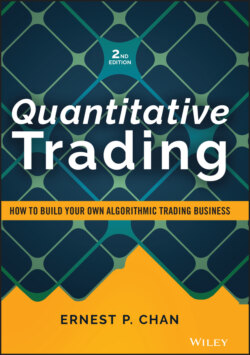Читать книгу Quantitative Trading - Ernest P. Chan - Страница 14
Demand on Time
ОглавлениеRunning most small businesses takes a lot of your time, at least initially. Quantitative trading takes relatively little of your time. By its very nature, quantitative trading is a highly automated business. Sometimes, the more you manually interfere with the system and override its decisions, the worse it will perform. (Again, more on this in Chapter 6.)
How much time you need to spend on day-to-day quantitative trading depends very much on the degree of automation you have achieved. For example, at a well-known hedge fund I used to work for, some colleagues come into the office only once a month. The rest of the time, they just sit at home and occasionally remotely monitor their office computer servers, which are trading for them.
When I started my independent quantitative trading career, I was in the middle of the pack in terms of automation. The largest block of time I needed to spend was in the morning before the market opened: I typically needed to run various programs to download and process the latest historical data, read company news that came up on my alert screen, run programs to generate the orders for the day, and then launch a few baskets of orders before the market opened and start a program that will launch orders automatically throughout the day. I would also update my spreadsheet to record the previous day's profit and loss (P&L) of the different strategies I ran based on the brokerages' statements. All of these took about two hours.
After that, I spent another half hour near the market close to direct the programs to exit various positions, manually check that those exit orders were correctly transmitted, and close down various automated programs properly.
In between market open and close, everything is supposed to be on autopilot. Alas, the spirit is willing but the flesh is weak: I often cannot resist the urge to take a look (sometimes many looks) at the intraday P&L of the various strategies on my trading screens. In extreme situations, I might even be transfixed by the huge swings in P&L and be tempted to intervene by manually exiting positions. Fortunately, I have learned to better resist the temptation as time goes on.
The urge to intervene manually is also strong when I have too much time on my hands. Hence, instead of just staring at your trading screen, it is actually important to engage yourself in some other, more healthful and enjoyable activities, such as going to the gym during the trading day.
As my automation improved and the assets under management grew (both my own and my investors’), fewer and fewer of these steps were taken manually, until they reached zero some years ago. Aside from monitoring and intervening when software and connectivity broke down (and they occasionally did), my colleagues and I routinely do absolutely nothing every day in terms of actually trading our strategies. We are in a fully autonomous vehicle, so to speak, except our eyes are still on the road and ready to apply the brakes when the system breaks down. Just like an autonomous vehicle, our automated trading system will send out all sorts of alarms to whoever is on duty when that happens.
(Lest you think my trader life is too idyllic to be true, the breakdown did happen when I was on a Caribbean beach during the Covid-19 selloff in February 2020. Fortunately, after frantically texting my office colleagues, we ended the day with a nice profit. What happened back at the cruise ship as it sailed back to Florida was a bit more troubling.)
When I said quantitative trading takes little of your time, I am referring to the operational side of the business. If you want to grow your business, or keep your current profits from declining due to increasing competition, you will need to spend time doing research and backtesting on new strategies. But research and development of new strategies is the creative part of any business, and it can be done whenever you want to. So, between the market's open and close, I do my research; answer emails; chat with other traders, collaborators, or clients; take a hike; and so on. I do some of that work in the evening and on weekends, too, but only when I feel like it—not because I am obligated to.
